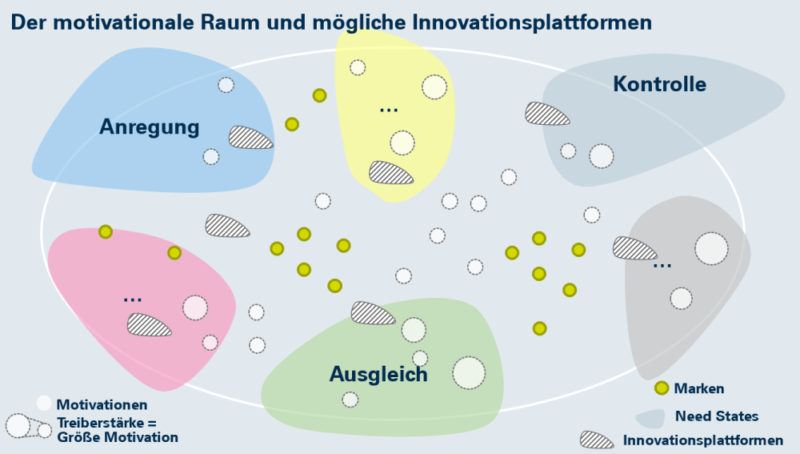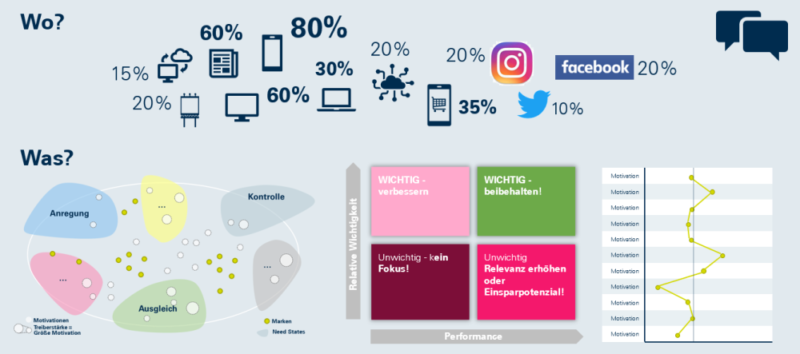
HOW TO PUSH YOUR BRAND DEVELOPMENT WITH ANALYSIS PACKAGES AT U&A
Basic research is essential. However, it unfolds its full potential with a clear objective. Sounds abstract? That can be solved! Here we show you three practical U&A (Usage and Attitude)applications for your brand development. Placement, Innovation, communication - three cases for tangible results.
01PRECISE BRAND POSITIONING THROUGH IMAGE AND DRIVER ANALYSIS
- Does the brand serve the relevant motivations of consumers?
- Does the desired positioning match the status quo?
- Which brands possess which image dimensions?
- Which dimensions contribute most to the brand equity?
Once the motivations in a market are being understood - for an example, qualitatively explored and quantitatively determined - a motivational map can be created. This shows us: Where do consumers currently perceive us? What brand image do they have? A comparison of the brand image with the competition not only clarifies the absolute image strength from the consumer's point of view, but we also learn something about the relative brand profile in the market under consideration: Where do brands position themselves on the image side beyond category-specific hygiene factors?
A driver analysis reveals the dimensions in which further development is worthwhile, i.e., where does clearer positioning help us to achieve stronger brand equity* and thus greater brand success? Marketing benefits, among other things, from comparing the strategically planned positioning with the consumer's image. This shows whether you are on track or not, and it provides indications as to the direction in which an adjustment might be worthwhile.

A motivation-based driver analysis of brand strength provides information about which motivations are worth emphasizing. Based on the brand perception, a motivational space can be created which reflects both the brand location and the need states as motivation clusters. The more relevant motivations according to the driver analysis can be highlighted here accordingly. Image: EARSandEYES
02BRAND VITALITY THROUGH MOTIVATION-BASED INNOVATIONS
Which innovations fit my brand and strengthen the desired brand positioning?
By understanding consumers' motivations through U&A, we can derive meaningful innovation platforms, i.e., topic areas, on which new product innovations can be developed. This is because we see which motivations play a role - which are attractive, which have mass appeal, which are more niche. At the same time, we also learn which motivations are already being focused on by our brand and which relevant motivations we are perhaps not yet sufficiently serving.
In combination with the desired brand positioning, this is then the perfect starting point to specifically fill the innovation pipeline with new product ideas. In this way, brand perception can be consistently supported in the desired direction.

In this way, relevant fields of innovation can be identified that are closer or further away from the current brand perception and can form the springboard for reinforcing the current perception or changing it. Image: EARSandEYES
03OPTIMISED BRAND COMMUNICATION THROUGH UNDERSTANDING OF CONTENT AND CHANNELS
How and where do I communicate best with my consumers as a brand?
What are the relevant aspects that need to be communicated?
The motivations and what consumers want to be picked up with in terms of content can be identified through the U&A. At the same time, one learns within the framework of the U&A how to communicate with consumers. At the same time, within the framework of the U&A, we learn from the observed or measured communication behaviour of consumers, how the exchange can take place in the desired tone and with the relevant content.
Here, the depth of knowledge too can be expanded via corresponding analysis modules - for an example, by checking the relevance of the communication channels (directly asked or indirectly derived) for the brand choice. This facilitates the prioritization of channels for the communication strategy.

Understanding where consumers engage with brands in that market helps us to decide where to communicate – comparing the relevance for decisions supports prioritisation. Promising content is derived from the motivational space, the analysed motivational hierarchy and a consideration of brand perception. Image: EARSandEYES
Did you like this article?
Get the latest articles delivered straight to your inbox once a month, free of charge.


